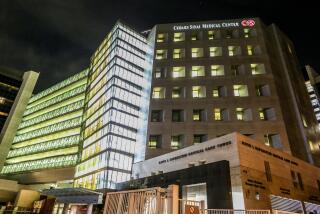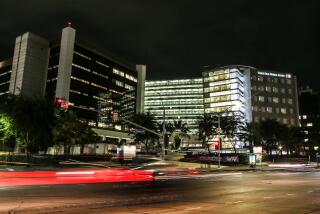Danger on the Cutting Edge? : Medicine: Done correctly, laparoscopy can dramatically ease the pain of surgery. But some doctors fear the new procedures are sometimes done by poorly trained surgeons.
- Share via
In surgery, as in everything else, practice makes perfect. But what if your surgeon is practicing on you?
Although surgeons traditionally try new procedures on animals, sooner or later they must operate on their first human patient. Studies show that doctors new to some operations are many times more likely to make mistakes than those with greater experience.
In one study, for instance, urologists reported a 14% rate of major complications early in their experience with rigid ureteroscopy--a method of viewing and treating kidney disease--compared to a 3% rate later.
The medical profession has long known this queasy fact and tried to reduce injuries by testing new procedures in academic medical centers and giving young doctors-in-training as much supervised experience as possible in those controlled environments.
But the knotty issues of unproven procedures and unpracticed surgeons have burst into public view because of widely reported problems with a popular new gallbladder operation called laparoscopic cholecystectomy. In only two years, without the usual academic testing and teaching, this procedure has become the preferred way of doing the nation’s half-million gallbladder removals annually.
And laparoscopy is quickly sweeping into most other kinds of surgery. Surgeons long out of medical school are scrambling to learn it because most operations eventually may be done this way. Some surgeons, without expert assistance, are trying it on patients even though their only experience has been a weekend course using animals.
“It’s the four-pig technique,” chides Dr. John Harding, medical director of Blue Shield of Western New York. “You operate on four pigs. If they live, you graduate.”
Making matters worse, many patients don’t know how to ask the right questions to protect themselves, and many doctors don’t routinely disclose their credentials and the risks involved.
Mariette Sinia, 59, of Pacific Beach has lived the dark side of the laparoscopic revolution. Her surgeon didn’t tell Sinia that her laparoscopic gallbladder operation was his first, says Lyn Goldberg, the lawyer who is representing Sinia in her lawsuit against the surgeon and hospital. (Both the surgeon’s attorney and hospital officials refused comment.)
Sinia’s doctor allegedly made a mistake that caused a devastating bile duct injury but didn’t recognize it for a week. What followed were two major corrective operations, weeks of hospitalization and a six-month absence from work. Two years later, she still suffers severe pain and difficulty walking. She’s at high risk of needing another operation, and liver failure and death are possible. Although physicians’ skill levels have always been of great concern, they’re getting more attention with increased computerized capacity to track individual doctors’ success rates. Public agencies and private groups are compiling doctors’ batting averages for different operations, such as coronary artery bypass. Patients already are being directed to hospitals and doctors with the best records for particular procedures.
Laparoscopic surgery is more difficult than open surgery and requires Nintendo-age skills, experts say. Doctors insert a thin tube attached to a TV camera, and several grasping and cutting tools, through small punctures in the skin, allowing them to see into the body and operate without large, painful incisions. But threading razor-sharp instruments through delicate organs and blood vessels by video leaves surgeons far from their familiar visual and tactile moorings.
Still, the technique spread rapidly as patients discovered its advantages--less risk of heart and lung problems and sharply reduced recovery time, pain and scarring. Aggressive hospital marketing--like one Westside hospital’s billboard of a woman sporting a Band-Aid over her belly button as the only mark of surgery--has pumped up patient demand.
Although laparoscopic surgery appears safe in experienced hands, surgical experts say that too many doctors are rushing to adopt the tricky new methods without adequate training and experience and that hospitals hungry for patients are failing to control them.
Some surgeons, particularly older ones, can’t do it and shouldn’t try, cautions Edward Phillips, associate clinical professor of surgery at USC. He and others agree that laparoscopy requires visual and motor skills that are beyond some older and/or less dexterous surgeons.
The dangers became clear with the recent release of New York hospital data that show a high rate of injury among laparoscopic gallbladder patients. Surgeons at top academic centers confirm a dramatic increase in injured gallbladder patients referred to them since the method became popular.
Many surgeons are honest with their patients about potential dangers of a new procedure. When Dr. Robert Brook of RAND, one of the nation’s top medical quality researchers, had a gallstone attack two years ago, he asked UCLA doctors to remove his gallbladder the new way. They refused, saying they were still learning, and referred him to Cedars-Sinai Medical Center, where surgeons had more experience.
The Cedars-Sinai doctors’ expertise paid off: Brook ate a big dinner hours after surgery.
But don’t expect all doctors to pass a paying patient onto a more experienced competitor, he says: “Not all people behave as nicely as the UCLA folks did.”
Neither the law nor medical ethics clearly say doctors must reveal their experience with a procedure or tell patients that the risks are greater with an inexperienced doctor. While lawyers and ethicists think they should, surgeons find the issue uncomfortable and many say it’s unnecessary.
“How would we get any beneficial new procedure out there if we had to tell patients we’re doing our first one?” asks Robert Fitzgibbons Jr., general surgery chief at Creighton University in Omaha.
But USC’s Phillips thinks surgeons should tell and patients should ask. He emphasizes that a surgeon’s first laparoscopic case can be safe if an expert is present and if surgeons are prepared to switch to an open procedure at the first sign of trouble.
The meteoric rise of laparoscopic procedures--first introduced in the mid-1980s and increasingly popular in the past three years--has exposed holes in professional self-regulation of new operations. The main controls are medical committees that decide whether doctors can perform particular procedures at each hospital. Since most new surgeries require neither national consensus nor government approval, the committees are the only check on what operations doctors can perform.
But the committees have varied tremendously in how strict they are on laparoscopic and other procedures, and that’s been the major weak link in medical self-policing, experts say. In many cases, committee members often include the same doctors who want to perform the operation in question, or close colleagues. Their decisions may significantly affect their own, their colleagues’ and their hospitals’ incomes.
Some hospitals, like Cedars-Sinai and Century City, have established strict rules. Since laparoscopic cholecystectomy was introduced, they have required surgeons to take a recognized course, practice on animals and do a number of human cases with an experienced supervisor, who judges their competence.
Although hospitals increasingly are moving in this direction, many still lack specific laparoscopic guidelines. They face strong economic pressure to let surgeons perform these procedures because of high patient demand.
Furthermore, there is no oversight of the courses offered to teach laparoscopic techniques. By all accounts, these courses vary widely in quality. Some last only a day or two, and some lack any hands-on practice on live animals. Surgeons nervously joke about colleagues who started teaching soon after attending a course or who started doing the new gallbladder operation after reading a manual.
Don’t expect health insurers to exert any control over new procedures. They largely have approved payment for the laparoscopic gallbladder procedure with little or no scrutiny of safety or surgeon qualifications. Supervising doctors is not their job, insurers say.
Experts fret that newer applications of laparoscopy are spreading in hospitals in almost the same uncontrolled way as cholecystectomy. These operations--which include hernia and ulcer repair, bowel resection, kidney removal, lung biopsy and appendectomy--have undergone even less testing for safety and effectiveness than the gallbladder operation.
Although the number of newer procedures have slowed somewhat, patients increasingly are pressing doctors to do them, particularly hernia repair. That worries surgeons like Brendan Carroll at Cedars-Sinai, who says the risks of hernia recurrences, bowel obstructions and other problems with laparoscopic hernia operations are still unknown.
“The next wave of laparoscopic complications we’ll hear about will be from hernia repairs,” he predicts. “Surgeons are afraid that if they don’t learn new laparoscopioc methods early, patients and referring doctors will go elsewhere.”
Society has been “derelict” in allowing new procedures to proliferate with almost no hard data on safety and efficacy, laments Dr. Mark Chassin, a renowned UCLA medical quality researcher who recently was named New York’s health commissioner. New York’s hospital injury reporting system is a partial exception; California and other states have nothing like it.
Chassin cites other applications of the techniques devised for lithotripsy (using sound waves to pulverize kidney stones) and angioplasty (using balloons to clear vessel blockages) as examples of technology run wild: “It’s the same story every time. Something appears as a breakthrough, then it’s used for all sorts of medical conditions for which its efficacy is impossible to prove.”
To control these problems, medical groups are introducing some unprecedented, though limited, standards. But compliance is voluntary, and many physician specialty groups don’t want to be bound by competing groups’ rules.
Gastrointestinal endoscopic surgeons issued recommendations for laparoscopic training and experience. But they stopped short of saying surgeons should do their first cases under expert supervision, which many surgical experts believe is necessary. The biggest surgeons’ group, the American College of Surgeons, insists laparoscopic-credentialing is up to individual hospitals.
Another new effort is a national patient monitoring system for laparoscopic bowel surgery, set up by colorectal surgeons. Their national society called this operation “unproven” and said it should be used only when its safety and efficacy are carefully monitored. But the group refused to limit it even more tightly to clinical trials.
The largest program to evaluate and set standards for particular procedures comes from internists, not surgeons. Their main group, the American College of Physicians, has issued guidelines for competence in 21 procedures.
The laparoscopic cholecystectomy issue has shaken surgical leaders. “It’s a wake-up call for all of us,” says Dr. Frederick Greene, the president of the gastrointestinal endoscopists’ society. “We can’t decide what to do to patients in a vacuum anymore. We must regulate ourselves if we are to avoid outside regulation.”
Malpractice lawyers already have picked up the scent. Carroll, of Cedars-Sinai, says he’s received about 20 requests from attorneys to review alleged laparoscopic cholecystectomy injuries.
“In some cases newer is better; in some cases it’s not,” he warns. “I hope this puts a glimmer of reality in people’s eyes . . . so when they see an ad for some great new operation they say, hey, maybe I need to think about this a little more.”






